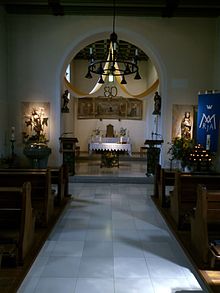Maria Immaculata (Weißenstadt)
The church Maria Immaculata , also called Marienkirche, is the parish church of the Roman Catholic parish Weißenstadt in the Upper Franconian district of Wunsiedel in the Fichtel Mountains . It is located at the intersection of Goethestrasse / An der Marienkirche (An der Marienkirche 3).
history
The church was built between 1934 and 1936 under the architect Georg Berlinger . It replaced the too small prayer room from 1912 in the house of the builder Emil Peruzzi (today Gartenstrasse 63). For this purpose, a church building association was founded in 1924 . The inauguration took place on August 29th and 30th, 1936. It is the first Catholic church building in the city after Weißenstadt fell victim to the Reformation in the 16th century and since then all Catholic life was extinguished until the end of the 19th century.
The alterations that shape today's interior were made after the Second Vatican Council according to the taste of the time, with the communion bench and pulpit being permanently removed. The western gallery was installed with the procurement of the present organ in 1970, and the present anteroom at the church portal was also built. In 2005 the sacred building was again extensively renovated and redesigned.
Building description
Exterior construction
The church is a hall building made of quarry stone masonry with a gable roof , plus a choir tower with a tent roof . The church is east. Its simple design takes up neo-Romanesque style elements and is reminiscent of a fortified church . The sacristy and sacristan's apartment are attached to the side of the church .
inner space
The ground floor of the tower forms the choir , which opens up to the nave through a high, neo-Romanesque arch. The ship itself is a cuboid hall. In the west there is a gallery for the organ and musicians. The upper end of the choir is a simple, painted wooden coffered ceiling with wrought iron applications; above the nave is a beamed ceiling in the same style.
Furnishing
Sanctuary
In the center of the choir is a stone high altar, the altar plate of which is supported by two granite columns. The altar bears a two-winged neo-Romanesque brass tabernacle. Above the altar, attached to the east wall, hangs a triptych showing the crucifixion of Jesus with Mary and John under the cross in the middle; on the left wing is the scene of the Annunciation , on the right the Visitation of the Virgin Mary . It was made shortly after the church was built by Max Rauh from Munich based on designs by Franz Doll , also from Munich.
Since the time after the liturgical reform of the Second Vatican Council, there has usually been a newer movable celebration altar with a wrought-iron substructure in the middle of the chancel. In front of it, on the left and right, stand (unusual for the small size of the church) two ambones , the design of which is strongly based on the moveable celebration altar.
Nave
At the front left of the chancel is the free-standing baptismal font (the semicircular shape is due to the fact that it was on the left wall of the choir arch until the redesign in 2005), behind it a wooden statue on the wall depicting the risen Christ, which was made in 2005 prepared. Opposite, to the right of the chancel, is a wooden statue of the Virgin, the date of which is estimated to be in the late 15th century. This most valuable piece of equipment was given to Pastor Fuß von Marktleuthen by the Wunsiedler Pastor Georg Hiegl in 1937 for the newly built church in Weißenstadt. This in turn received the figure from the estate of Pastor Meuten von Mettenbach near Landshut.
The church stalls are (since 2005) divided into two blocks, moved to the left and right of the side walls of the nave and form a central aisle.
organ
The first organ in the church, which still exists today, replaced the harmonies that had been used up until then in 1970 and was placed on a specially built west gallery. It comes from master organ builder G. Christian Lobback from Hamburg . It has nine registers on two manuals and a pedal with mechanical playing and register action .
Disposition
|
|
|
|||||||||||||||||||||||||||
-
Pairing :
- Normal coupling: II / P, I / P, II / I (as steps)
Bells
The tower houses three bells : the Marien and Bonifatius bell were cast by Hofweber in Regensburg in 1964 and replace the two previous bells given for war purposes in the Second World War . The Josefs bell, cast near Hamm in Regensburg, has been preserved from the pre-war period. The tones of the three bells form the Te Deum motif (minor third , major second ).
use
The building is the only church in the parish "Maria Immaculata" Weißenstadt (since 1951 Expositur, from 1977 parish curate, on December 8, 2001 raised to parish). However, this is part of a parish community with Kirchenlamitz and Markleuthen.
literature
- Georg Krauss: Weißenstädter Heimatbuch. Kießling, Weidener Werbedruck, Weiden / Opf. 1971.
- Karl Ott: Weißenstadt in memory. Kießling advertising printing and publishing.
- Parish Weißenstadt: 70 years catholic. Marienkirche St. Marien (1936-2006) in Weißenstadt. 2006.
Web links
- official website of the parish of Marktleuthen (seat of the pastor of the parish community)
- official website of the Diocese of Regensburg
Coordinates: 50 ° 6 '12.4 " N , 11 ° 53' 26.9" E




